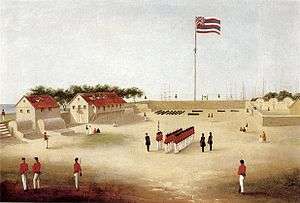French invasion of Honolulu
| French Invasion | |||||||
|---|---|---|---|---|---|---|---|
 Honolulu Fort, 1853 | |||||||
| |||||||
| Belligerents | |||||||
|
|
| ||||||
| Commanders and leaders | |||||||
|
|
| ||||||
| Strength | |||||||
|
1 frigate 1 corvette 140 Marines | 1 fortress | ||||||
The French invasion of Honolulu (also known as the Sacking of Honolulu, or the Tromelin Affair) was an attack on Honolulu by Louis Tromelin in retribution for the local persecution of Catholics and repression of French trade.
Prelude
On August 12, 1849, French admiral Louis Tromelin arrived in Honolulu Harbor on the corvette Gassendi with the frigate La Poursuivante.[1] While in Honolulu, De Tromelin found out about the past persecution of Catholics and the high tariffs on French brandy from French Consul William Patrice Dillon, who oversaw French interests in Hawaii. De Tromelin, angered by the ABCFM missionaries’ intention to shut out Catholicism and French trade, made ten demands to King Kamehameha III on August 22.[2]
- The complete and loyal adoption of the treaty of March 26th 1846.
- The reduction of the duty on French brandy to fifty per cent ad valorem.
- The subjection of Catholic schools to the direction of the chief of the French Mission and to special inspectors not Protestants and a treatment rigorously equal granted to the two worships and to their schools.
- The use of the French language in all business intercourse between French citizens and the Hawaiian Government.
- The withdrawal of the alleged exception by which French whalers which imported wine and spirits were affected and the abrogation of a regulation which obliged vessels laden with liquors to pay the custom house officers placed on board to superintend their loading and unloading.
- The return of all duties collected by virtue of the regulation the withdrawal of which was demanded by the fifth article.
- The return of a fine of twenty-five dollars paid by the whale ship General Teste besides an indemnity of sixty dollars for the time that she was detained in port.
- The punishment of certain school boys whose impious conduct in church had occasioned complaint.
- The removal of the governor of Hawaii for allowing the domicile of a priest to be violated by police officers who entered it to make an arrest or the order that the governor make reparation to that missionary.
- The payment to a French hotel keeper of the damages committed in his house by sailors from HBM″s [His Britannic Majesty's] ship Amphitrite.[1]
Sacking of Honolulu
The demands had not been met by August 25. After a second warning to the civilians of the impending invasion,[3] 140 French Marines, two field pieces, and scaling ladders were landed by boat. The marines overwhelmed and captured Honolulu Fort from the two men defending it, Governor of Oahu Mataio Kekuanaoa and Marshal of the Kingdom Warren Goodale, who did not resist, the fort having been evacuated before the French landed.[4] The marines spiked the coastal guns, threw kegs of powder into the harbor and destroyed all the other weapons they found (mainly muskets and ammunition). They raided government buildings and general property in Honolulu, causing $100,000 in damages. They also took the king's yacht, Kamehameha III, which was sailed to Tahiti and never returned.[5] After these raids, the invasion force withdrew to the fort. During the occupation, men in Honolulu ridiculed the French, and on August 30 they organized a mock attack party making the marines double their guard and send skirmishing patrols out late into night, encountering no attackers. De Tromelin eventually recalled his men and left Hawaii on September 5.[6]
Aftermath
Gerrit P. Judd led a party to inquire and settle the incident, leaving for Paris on September 11. Along the way Judd requested support from the United States and Great Britain, the latter accepting for his case against Tromelin.[7] At first the French government condemned the attack on Honolulu but with the account of Tromelin and Dillon who left with Tromelin on September 5, the French government reconsidered the incident as more justified and did not make reparation for the damages.[8]
References
Bibliography
- Daws, Gavan (December 1974), Shoal of Time: A History of the Hawaiian Islands, University of Hawaii Press, ISBN 978-0-8248-0324-7
- Kuykendall, Ralph S. (1938), The Hawaiian Kingdom: Volume 1: Foundation and Transformation, 1778-1854, University of Hawaii Press, ISBN 978-0-87022-431-7
- Owen, Jean Allan (1898), The story of Hawaii, Harper & Brothers
- Alexander, William De Witt (1891), A brief history of the Hawaiian people, Board of Education of the Hawaiian Kingdom., ISBN 978-0-89875-324-0
- Hawaiian Journal of History: Devoted to the history of Hawaii, Polynesia and the Pacific area, Volume IV, 1967
- Chariot, Jean (1970). "An 1849 Hawaiian Broadside". Hawaiian Journal of History. 4. Hawaii Historical Society. pp. 96–104. hdl:10524/266.